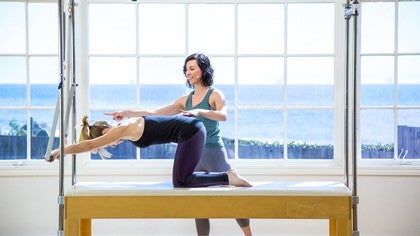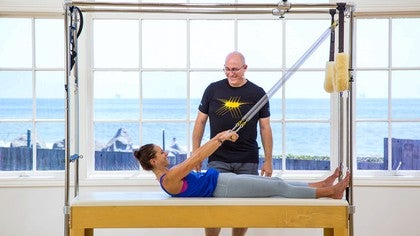Description
About This Video
Transcript
Read Full Transcript
Hi everybody. It's Jo. I'm back here at [inaudible] anytime. So lucky to work with Amy here to take you through a series of exercises on the Cadillac. We're going to be using the push through bar and all of these exercises revolve around the idea of finding length and release in a tight, lower back. So working into the hips, working into the shoulders rather than just flexing forward as we're always so tempted to do. So when we do curve the spine, it'll be really elongated. But finding that strength from the center of the body is really going to help us out.
So we're going to start a seated on the Cadillac with one red spring on this balanced body piece of equipment. And Amy, I'm going to pass you the bar. You have it. And we're going to start with the elbows bent in at the waist. And so when we're here in this position, we want to find a sense of weightedness and groundedness through the pelvis deep into the upholstery. So that from there we can find a sense of lift. I'm gonna Guide you, Amy, so that your ribcage is just a little further forward.
And then when your elbows come back, this position here hopefully will be nice and familiar to you. So we're gonna come back to this shape many times through the exercise. So from here, let's Elongate the arms forward that maintain everything else in the same alignment. Beautiful. Our next step is to create a hinge ing motion at the hips. So we are going to tip the pelvis forward and take everything along with it. Pausing here and really thinking about taking the whole spine forward at the same pace as the pelvis. Great holding there.
The best idea when doing this exercise is just to really think about drawing your thigh bones is deep into the hips as possible, so you're basically in a seated squat alignment and then you can focus on the elongation through there. Amy, you can go a little further if you feel like it can come from your pelvis. Great. Okay. When we're at the bottom of our squat, that's when we can find some elongation through the lat. So now the bar can start to move forward. And as it does so you'll feel that elongation further and further and further. And thinking about where the lots attach at the top of the arm here and allowing the movement of the bar to take you a little further. Beautiful.
As you're doing this motion, continue to focus on the sense of weightedness through the pelvis, but lift and length through the spine. When you've reached the end of your position, we're going to let the eye-gaze come in a little and feel your pelvis come back into a little post here until pausing here. This is where it's really tempting to just push back into that flex position cause we're so hungry for that, that stretch feeling. So I like to imagine my bladder is falling back into the pelvic bowl. And in doing so the pelvis will come through.
You can even allow your head to come down a little more. Amy. Perfect. And now you can see that we've set the pelvis up exactly stacked onto these table. So from here we can restack the spine, one vertebrae at a time. As we've all heard it said before, and then the elbows will bend and we're back at the stop position. So we can run through that one more time. Just add a nice easy pace softening through the rib cage. Perfect. And now thinking about your squat, so drawing the fide deeper and deeper and deeper into the pelvis.
Widening the sitting bones, feeling that lift through the waist. Oh, that's so good. Now when we're at the end of the squat, that's when we allow the bar to guide our lats into that length and position. Perfect. Noticing that space between each of the vertebra expanding, even though our focus is more on the bigger muscle, up, higher through the body, when Oh look at that range increase just in the second repetition. Perfect. From here, let's take a really beautiful inhale into the back of the body so that as you exhale, you can not gently send the bladder back into the pelvis and once the pelvis is back into that neutral position, rebuild the spine.
I can feel myself elongating along with Amy and then the elbows can come on back home. So usually we would do up to five repetitions of this exercise, but we're going to move on now to a little seated twist exercise. So Amy, place your right hand onto the bar, into the center, and then the left hand will go back here into the small of the back. Yeah, and I'm going to, I've chosen this position for Amy because I think it's going to be useful for her to understand where her pelvis is because you can imagine that it's going to be really tempting to create a rotation through the helpless or through the hips. But you could take your hand onto your chest if you prefer or onto the back of your head as Amy was going to do. So from here, we're just going to go ahead and straighten the elbow. Perfect. And once we get there, this is where it gets tricky because it's so tempting to just create the movement through the arms. So we're going to have in a sense of awareness through the back of the shoulder and really think about creating that rotation through the spine itself. Pausing here. Now let's do a test.
Can you draw the arm back into the shoulder a little good. And then could you keep your arm where it is and rotate a little further? Yes. Perfect. State effort and inhalation. And then as we exhale, we're going to rotate the body back around. Feel the way the arm settles back into the shoulder and we'll bend the elbow just so we get a sense of groundedness and home. Good. And you can say that Amy just settled into the table there.
We'll do one more time. So lengthening through the elbow and then as rotate, feeling that groundedness down and that little lift up. Taking an inhale here into the my hands and as you exhale, go deeper into the table to find more length around. Fantastic. Inhale. And then exhale drawer at, back around to center. And let's do the other side just so you can get a sense of what it looks like from the back. So first thing we need to do is find that sense of weightedness through the hips.
Amy and I tend to do the same thing of wanting to send our rib cage forward. So you're going to breathe into the back of the body. That's going to help a lot. And then whenever you're ready, Amy, go ahead and straighten the arm and we'll rotate the body and my having my hands here on the ribcage, I can get a sense of the pace that the left side of the body is moving compared to the right. So I would like you to breathe into the right side of your ribs a little more. And as you exhale, just soften into a little more rotation. Yes, stay there and inhale fund the elongation, but all the groundedness and then rotate back home. Good.
And we'll do one more so that Amy's nice and symmetrical, rotating the body around. Good. This is where it's tempting to side Ben. So Amy, I'm going to get you to pause there and find a little more length on the left side. Hold. Find the weight equally through both sitting bones. Yes. And then rotate that last little bit. Beautiful. And then let's bring it back around to the center. Great. So Amy, I'm going to have you place both hands on the bar and pass the bar to me.
I have it. You can let go and we're going to swing the bar around the other way now. So sticking with one red spring, we're going to go into a kneeling position. So kneeling facing the bar and taking both hands onto the bar and we'll press the bar down. Good. So this exercise came about when I was really keen to teach my client Jody the kneeling cat, but I remembered that flection really wasn't great for her body.
So came up with this neutral spine version instead. So again we're working with the concept of a hip hinge but also that sense of pivot happening through the shoulder joint. So we're going to start the movement almost like you're taking a bell. So picture your audience right there in front of you and we're going to start to pivot forward from the hip, allowing the bar to travel forward. Good. Until we find sort of like a quad repaired position. Perfect.
Keep going forward. More and more and more and more. Great Pelvis is perfect where it is here. If you feel comfortable to let the bar go further, go ahead. Great. Pausing here. Now we're going to send the body backwards. We maintain the neutral spine.
The bar is actually going to direct us to maintain neutral. Try not to go into flection. Widen the sitting bone so that your hips can go back. That's it. Perfect. And then you land on your feet. Now from here again, maintaining that neutral spine, we're going to let the bar direct us into a low kneeling position.
So you're going to look forward, beautiful, and hold it there. Now creating a down pressure through your arms. You're going to press down through your shins and that's going to levitate you back to the start position. So from here we folded the hips to send your gaze forward a little and find the elongation through the back line of the body. Beautiful work. Now visualize the bar directing you back home.
Widening those sitting bones, feeling that elongation as you push the bar forward, and then the bar responds by pushing you back. You've got it. Now from here, we're going to hinge up through the hips, but also through the shoulders hold. This is where again, it's tempting to go into the ribs. And now we'll press down and lift up. Shall we do one more? Okay. But let's hinge forward. Beautiful work.
Continue to find that pivot of the pelvis so that the sacrum is facing the ceiling. Now from here, be guided by the push through bar as it directs you back home. [inaudible] nicely done. And then from here we're going to pivot through the shoulders, pivot through the hips. Fantastic. And now this fits my favorite. The push down to lift up. We can reverse this. So we're going to sit the bottom down, allow the pedal to move forward. Great.
From here, the bar is actually going to come down again as you come forward into a flat line. And then we travel forward with the bar. Good. And this bit's a little harder. Now the bar comes back towards you to come up to a high kneeling and a little more challenging to pivot that pelvis over those lifted femur bones. So again, we sit back. Good. And then pivot forward, taking the bar with you, elongating the spine. Quite challenging on that red spring.
We move forward and then take the bar up or the body up last time sitting down. Good. And this is really challenging for those of us who are a little tighter through the glutes and convincing the body to come down nice and cleanly through the hips moving forward. But we're going to pause here because how good does an kneeling cat feel? So let's actually flex the spine here, finding that lift through the upper abdominals. Great. Hold it there Amy.
And find a relationship with the boss. So really pressing down into it. Good. Now maintaining this flection, we can see that the apex of the curve is up here in the earth, thoracic. So we're going to shift it down. So Amy, I'd like you to stay flex, but sit into your hips. So is coming back almost until like a knee stretch. So pausing there, see if you can release your glutes so that your bottom will come down closer to your feet. She has it perfect. Holding there and now you would feel the stretch much lower on your spine.
So we're going to create down energy through the shins to come forward, but still stay in the same shape. Yes, beautiful job. Breathing into the back. Feels really good here. We're going to send the pelvis back. Great. Good. Hold it there. Find the way you can energize your arms into the bar. Beautiful. And that's really opened up the back of the shoulders. We'll go forward two more times. Pressing down good.
And then coming back. So really massaging that lower back area. One more time pressing forward, but using strengths to get there. Good. And then let's flatten out. Enjoy that elongation. Go forward and forward and forward.
And now we'll roll up as we would traditionally. So curling through the pelvis, feeling that lift, but reaching down, down, down to find, those are roots that are really going to give us our support. Perfect. Okay, so let's take the bar up now for this next exercise, we're going into a more familiar position. So Amy, I'll have you lying down on your back with your head right here. We're going to play with the teaser a little bit here. So legs are going to be long and energized through to the other side of the room. I'm going to go ahead and pass the bar to you and for this one we want to make sure that your your head or your client's head is right at the very edge of the table as Amy is now. Perfect. So from here, we have done this before, I'm sure with the spring from below, but I'm want to work with the spring from above for this one.
So let's take a breath in and as you exhale just come up into that chest lift position. Perfect. And finding that lift and length and what might be familiar to you now is that sense of openness through the back of the body that we were able to find during the kneeling cat. Good. So this is what we're going to work with now as you start to roll on up. Good. And we're going to go past the regular teaser position right up into a tall fit.
And this is where we want to find that lift. Lift your eye-gaze just a little, imagine there's a beautiful beach in front of you. Take a breath in and then as you exhale, maintain the lift and you'll see that the spring is off tension, but we're going to roll through the pelvis, which is the tricky part. That's it. So continuing to lay the body down, one row of ribs at a time, coming down into the mat. Beautiful job. And then the head will rest. So again, inhaling through the nose, exhale as you start to curl forward, really finding the elongation in the chest lift, which I think for a lot of us is really challenging. So pausing here, can you lengthen through your lots a little further? Yes. And now let's continue all the way up. Up, up.
I'm going to come around to the back of Amy just to give her a little more encouragement to come up further and further and further. Lifting the heart forward, lifting the eye, gaze up a little and just sending the head back so that it's through your arms. Great. Inhale here in length and a little further and then as you exhale, come back, knock it back from the pelvis rather than from the mid back. Good and length and the waist all the way down. We're going to do one more, Amy, you're with me. Let's do it. So in how prep. Exhale, let's curl it up. Really finding that elongation as you come on through. Beautiful.
A lovely arc. From one hand through to the next. And then we're going to squeeze the toothpaste tube from the center. Lift, lift, lift. Find the openness through the heart rather than through the lower ribs you have it now it's the bladder that falls back first. We're going to roll onto the sacrum, the whole length of it, and then the waist gets longer and longer. The legs get longer and longer and she has it beautifully done.
Cool. I'm going to go ahead and take the bar. You can let go and we're going to stay basically facing this side of the table. But you're going to sit up and straddle the Hattie, so your legs are going to be on either side. And for this exercise we're going to take two red springs and attach it to the bar. Great. So really working from all of the previous exercises to find a sense of weightedness through the pelvis, lift through the waist without popping into those lower ribs. So just coming on back here. Excellent.
Taking your hands onto the bar, Amy palms facing you. And this is again where it's going to be really tempting for those ribs to pop forward. But what we can do instead is find that space between the shoulder blades and find that sense of reach from the bottom of the shoulder blades, forward elongation through the triceps as well as through the laps. Excellent. Now this is quite a strong amount of resistance.
So as the bar comes further and further, and Amy, you can go ahead and start to pull the bar down. Of course, we're going to fall into our natural compensatory patterns. So around here pores, this is where it's tempting to send those ribs forward. So we're going to resist that temptation, find our strength from grounded-ness and then proceed a little further and further and further and hold. And Justin being here, feeling a sense of weightedness through the elbows, through the hips. Find length to compliment that and excellent work. Let's start to move forward, allowing the bar to travel back home, feeling that lift that it gives you and relief as well.
And again, we breathe and start to draw it down. So it's this powerful lift coming up through the spine rather than moving forward or back breeding laterally here. And then as you exhale, I would start from the pelvis having an awareness of that drawing down. As the bar moves up, I'm going to watch from the front as Amy does. Two more. So breathing out and drawing down, finding that lift holds holdings, the fun part. And then exhale, pelvis goes down. Find the lift through the waist, the reach forward through the elbows.
One more time. Breathing out to draw it down. Can you lengthen through your neck in the same way as you can? Lengthen through your lumbar spine and controlling the bar back home. It's quite a hating the variation. So these are a really great little series that you can do to find that length through the spine. So to add onto that lovely little series, especially if we're coming to the end of your workout, there's a little standing exercise that really brings all of these points together that I think will feel really great and will be an extra challenge in that standing position.
So the final variation in our little series of elongation for the trunk is here in a standing position. So again, we have the one red spring, Amy, you can go ahead and hold onto the push through bar and once you've got your hands on it, let's push the bar down so that your arms are lengthened. Excellent. So before we get started, you can choose a foot position that's going to work for you. So the wider your feet are positioned, the easier it is going to be to find that squat position. So don't feel that you have to be exactly with your feet directly under your hip sockets. It's totally fine to go a little wider up. So from here, we're going to maintain a neutral spine for the majority of this series. So let's begin in a standing bow. So again, your audience awaits you. Amy left pivot at the hip, and we really want to think about finding elongation in this position rather than dropping down.
We're moving as far forward through the body as you possibly can, and also reaching the sitting bones back to the wall behind you. Breathing in through the nose, into the sides of the body. And then from here we returned to upright. So we did this earlier in kneeling, but this is a lot more challenging in a standing position. From here, we move into a squat. So Amy's going to go ahead and bend through the hips. Of course, the knees and the ankles are bending as well, but we really want to focus on finding that weightedness down low because coupled with the lift of the spring pulling up, we're going to have some beautiful sense of space created through the body here. And even just staying here for a few breaths is totally fine so you can get further and further relief from here.
We're going to use the arms because what we want to avoid is going back to the old pattern of gripping through the back. So let's create a firm hold. Bend the elbows and feel that surge from the ground to lift you back up. Let's do two more times. So fold it forward through the hip. Really find the opposition through the movement. How far can you reach your sitting bones back and find that link through the crown of the head forward. Inhale into that cause it just feels so good.
As you exhale, use your feet. Find the lift up. And now we get to go back down to the ground. Bending through the hips, through the knees, through the ankles. How much space and length can you create through your lats and through your triceps? That looks so good. I'm kind of jealous. And then you're going to bend the elbows and pull on up last time. Send it forward. Breathe into it.
That looks so nice. From here, we're gonna pivot back up. Find the lift. Find the ground, bend the knees. How much reach can you find through your arms as you go deeper and deeper into your hips and ankles. So good now, grip strength, shoulder stability. Pull yourself up. Thank you so much. Thank you so much, Amy, and I hope that you find some relief through any tightness in your back without having to stretch or roll yourself out too much. Thank you. Bye.
Tower & Cadillac Workouts: Intermediate Cadillac Workouts
Comments
You need to be a subscriber to post a comment.
Please Log In or Create an Account to start your free trial.


































